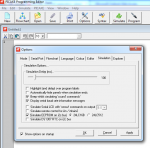nerdegutta
Senior Member
Hi.
Can someone please explain to me how to use the 24LC16b EEPROM?
I need to store 18 bytes as many times as I can.
If I understand correctly:
Block 000 can store 256 bytes
Block 001 can store 256 bytes
Block 010 can store 256 bytes
Block 100 can store 256 bytes
Block 111 can store 256 bytes
Block 110 can store 256 bytes
Block 101 can store 256 bytes
Block 011 can store 256 bytes
8 blocks * 256 bytes = 2048 bytes
I've read the datasheet, and it says 8 * 256 * 8. That would make 16384 bytes. This I don't understand.
How can I use the whole IC,and how do I change between the blocks, after one is full.
Appreciate all help.
- nerdegutta
Can someone please explain to me how to use the 24LC16b EEPROM?
I need to store 18 bytes as many times as I can.
If I understand correctly:
Block 000 can store 256 bytes
Block 001 can store 256 bytes
Block 010 can store 256 bytes
Block 100 can store 256 bytes
Block 111 can store 256 bytes
Block 110 can store 256 bytes
Block 101 can store 256 bytes
Block 011 can store 256 bytes
8 blocks * 256 bytes = 2048 bytes
I've read the datasheet, and it says 8 * 256 * 8. That would make 16384 bytes. This I don't understand.
How can I use the whole IC,and how do I change between the blocks, after one is full.
Appreciate all help.
- nerdegutta

